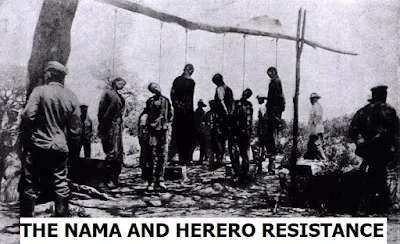THE NAMA AND HERERO RESISTANCE (1904 – 1907)
This was
an African resistance
which was waged
by the Nama
and Herero people in
present day Namibia
from January 1904 – 1907.Originally, three main
ethnic groups occupied
Namibia, these were : The Ambo,
the Herero and
the Nama. The Ambo and
the Herero consisted
of Bantu group
and engaged in
animal husbandry and
crop cultivation. The Nama
were the Hottentots who
were traditionally the
pastoralists. Both of them
valued land for
crop cultivation and animal
husbandry.
The settlement
of the Bantu
(The Ambo and
Herero) in Namibia triggered
traditional conflicts between
them and the
Hottentots’(Nama). This was due
to the fact
that both of
them valued land
for economic activities, The Bantu
for Cultivation while
the Hottentots’ for livestock keeping. The hostility
went on until
the arrival of
the Europeans, who also manipulated
this rivalry for
their benefit.
The Herero
received warmly the
Germans as the
Herero hoped that
the whites would
assist them against
their rivals, Nama. Soon after
their arrival in
Herero land, the Germans declared
a protectorate over
Namibia and established
their administration. Worse
enough, the Germans set
up a military
base at Windhoek
and launched various
attacks on the
Nama between 1884 and
1904.
The Germans created
various economic and
political policies that
provoked the outbreak
of the resistance.
For example in
1903, they inaugurated the Settler
Policy that demanded
Africans(Both Nama and
the Herero) to move
out their land
and give to
white settlers. In January 1904, there w as a massive
Herero revolt against
the Germans. The Nama joined
the war
in October in
the same year. The Nama were under Hendrick Witbooi while the Herero were
under Chief Samuel Maherero.
REASONS FOR THE OUTBREAK OF NAMA AND HERERO
RESISTANCE
Both the
Nama and Herero
had political, social and
economic discontent as
follows:-
i.
Land
alienation. The
German settlers alienated
and occupied fertile
land of the
Africans and pushed them
into unproductive land. This
created hostility between
Africans and German
government something that
led to the
resistance .
ii.
Cattle
confiscation. The
Nama and Herero depended much
on cattle for
their survival. The Germans seized
their cattle in order to compel
them to work
in German farms
and mines. This angered
them very much hence
Nama and Herero
resistance.
iii.
Introduction
to forced labor. In 1896, the Germans introduced
forced labor as
they demanded laborers
in their economic sectors. The Nama
and Herero were
forced to work
in railway construction, public buildings, plantation and
mines. Worse enough they
were paid lowly. This
resulted into Nama
and Herero resistance.
iv.
The
outbreak of rinderpest disease. In 1903, there
was outbreak of
rinderpest, the epidemic that
swept away many
Nama and Herero
cattle. The Native leaders
and other spiritual
leaders expounded this
epidemics as a
curse from the
ancestors who were
unhappy with the
presence of the
white men ion the
country. Therefore, this
made the Nama and
Herero to wage a
resistance against the
Germans.
v.
Creation
of reserves. In
1903, the colonial administration created
area of reserves
for the Herero
and Nama. That means, the
Nama and Herero
were forced to go and
live in
the reserves near
the Kalahari desert. These
reserves were barren
and infected with
tsetse flies. This as
a result led
to the resistance.
vi.
Payment
of debts. Soon after the arrival
of the Germans
in Herero land, they established
commercial relationship with
Africans where Africans (Herero) borrowed money
from the Germans. But
later on, the Africans failed
to pay their debts
then the Germans
started to force
them to repay. Worse
enough, the Germans demanded
from the Africans
high interest, that they
were unable to pay
and found themselves
in debt trap. In
1903, the Colonial government
introduced a Credit Ordinance
which stated that
all German money lenders
were mandated to accumulated/
collect their debts
from Africans for the
duration of one year. After that period, the debt
would be invalid. With
this permission, the Germans
seized African cattle
and land and
sold them in order
to regain their
money. This angered Chief
Maherero and his
Africans something which
led to the
resistance.
vii.
German
administration. Both the Nama and Herero were disgusted by the
German administration that
never paid attention
to the traditional
authority. The tradition of
chiefs were not
consulted in policy
making something which affected their
leadership position. This
led to
Nama and Herero so as
to regain their
political independence.
viii.
Cultural
interference. The Nama and Herero were not happy with the
new culture introduced by the Germans especially the new religion,
Christianity. Therefore, Africans resisted because they wanted to maintain
their culture.
EFFECTS OF NAMA AND HERERO RESISTANCE
a)
Depopulation -
Many people lost their lives while others got severe sufferings. This as a
result led to depopulation in Namibia.
b)
Land
alienation - The natives in Namibia lost their land after
the war. The Nama and Herero were thrown out of their fertile land and taken to
reserve areas near the Kalahari Desert where many of them died.
c)
Cattle
confiscation - The Nama and Herero lost all their cattle
after the war. The German government deprived all their cattle.
d)
Creation
of concentration camps - The Germany government introduced the
concentration camps where thousands of women and children were grouped there
and many of them died of hunger.
e)
Total
colonialism - The defeat of the Nama and Herero paved way
for total colonialism in Namibia where the Germans established their colonial
government.
Tags
HISTORY

